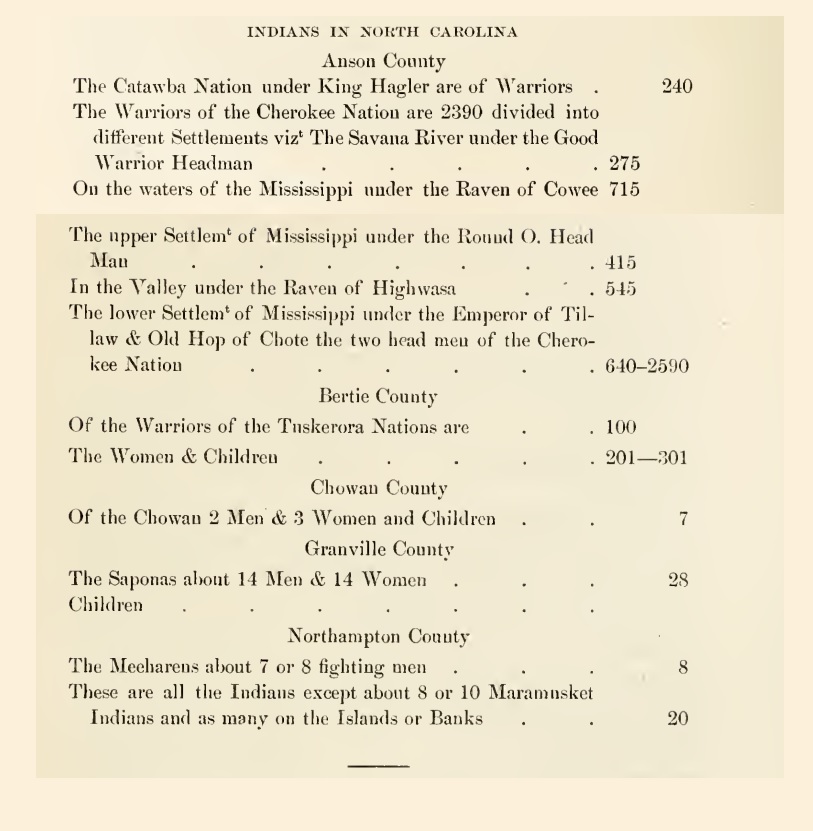1726
“Read the petition of the Meherron Indians complaining against divers of the inhabitants of this Government for molesting them in their settlements and taking up their lands. At the same time was read also the petition of Beale Brown (and) Edward Powers in behalf of themselves and others living near the said Indians, for molesting them. Ordered, that the parties on each side do attend this Board at their sitting in October next. And that in the meantime, neither of the said parties give one another any disturbance in their settlements.”
Colonial Records of North Carolina II: 639-640. August 3, 1726.
1726
Colonial Records of North Carolina II: 640 August 25, 1726.
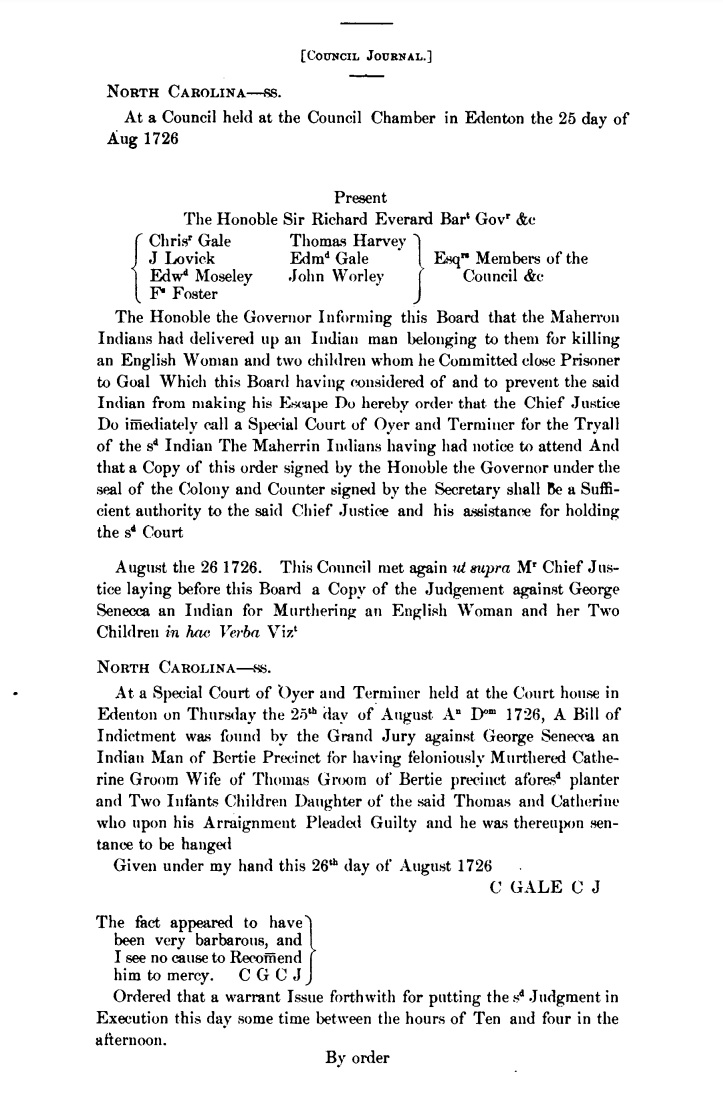
1726
The Baron De Graffen Reed offering his Oath that one Nick Major in Particular being one of the present Maherrin Indians sat with the Tuscaroroes at his trial and was among them when Mr Lawson the Surveyor General was killed by them…
(Saunders, Vol. 11:641-645; October 27, 1726)
(The Secret History of the Meherrin pages 93-94)
1726
In the North Carolina Governor’s Council from October 1726, it was read that the
Meherrin settled in an “old Sapponie town”. The Saponi Indians also lived along what is now the North Carolina and Virginia border, and were invited to the North Carolina side provided they would be allies during the Tuscarora War.
(WEAPEMEOC SHORES: THE LOSS OF TRADITIONAL MARITIME CULTURE AMONG THE WEAPEMEOC INDIANS by Whitney R. Petrey. page 131)
1726
The Meherrins were assigned to a new reservation tract by the North Carolina General Assembly. This reservation greatly reduced the size of the reservation established by the Virginia Colony in 1705. The tract of land was located at the abandoned Chowanoke fields, at what is today called “Parker’s Ferry.” the Surveyor do lay out a Tract of 150 acres the most Convenient to his Dwelling. Which Lands when Surveyed, the Surveyor is to make return thereof into the Secretary’s Office that Grants may pass for the same to the said Indians. It is further Ordered by this Board that the said Indians shall Quietly hold the said Lands without any molestation or disturbance of any Persons claiming the same so as the same Persons Right or pretentions to the said Lands be Reserved unto them Whereby they or those claiming under them shall have the preferrence of taking up the same when the said Indians shall desart or remove therefrom.
(The Colonial Records of North Carolina, Second Series – Volume VII – Records of the Executive Council – 1674-1734.)
1726
In 1726, the government of North Carolina acknowledged the Meherrin’s rights to a six-mile reservation in the land called “Meherrin Neck” which later became known as Maney’s Neck, and in the 20th century, Parker’s Ferry.
(The Secret History of the Meherrin page 8.)
1726
Oct 27-Oct 28, 1726
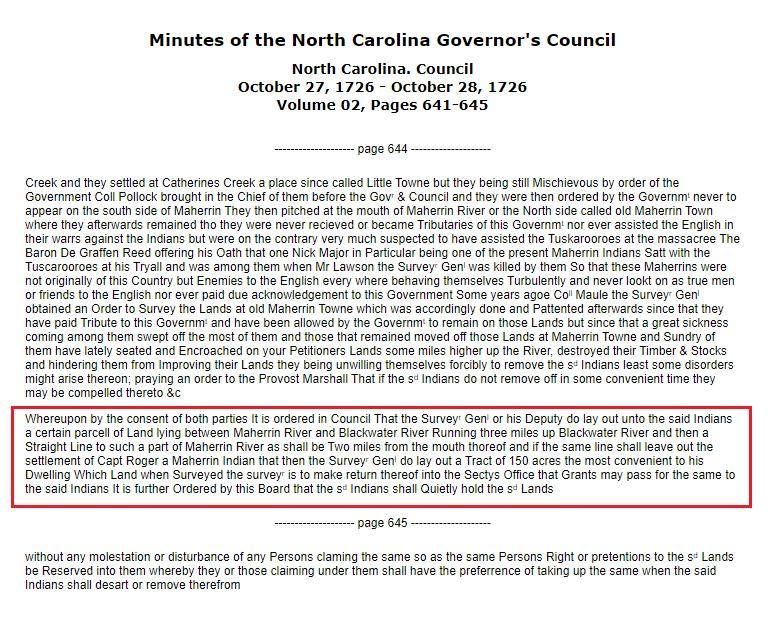
1726
In 1726, they (Meherrin) were settled across the river in Gates County, near the Chowanoke Indian territory, while a major settlement at Potecasi Creek in the swampy western half of the county appears to date from the second half of the 18th century.
(The Secret History of the Meherrin)
1726
Grand Jury Verdict “The Jurors for our Soverign Lord the King on their Oath do present that George Seneka an Indian Man of Bertie precinct not having the fear of God before his eyes but movd by ye instigation of the Devil & his own Cruel Peirce & Savage nature Vizi in Bertie precinct aforesayd on or about ye twenty fifth day of July one thousand seven hundred & twenty six by force & Arms an Assault did make upon Catherine Groom the Wife of Thomas Groom of Bertie & on two Infant Children Daughters of the sayd Thomas & Catherine Groom & with an Axe of the value of two shillings which in his hand he then he the sayd George feloniously Voluntarily and of malice forethought in Bertie precinct aforesaid Struck & barbarously wounded the sayd Catherine on the head & also the sayd two Infants with the sd Instrument then & there in like manner did wound so that of the sayd Cruel wounds the sayd Catherine & the sd two infants did then & there instantly dye & so the Jurors aforesayd on their sayd Oath do way that the sayd George … of malice forethought feloniously & voluntarily did kill & murder…”
North Carolina Colonial Records (Saunders) II: 665. August 25, 1726.
1726
Council Hearing on Meherrin Murder Trial
“The Honoble the Governor Informing this Board that the Maherron Indians had delivered up an Indian man belonging to them for killing an English Woman and two children whom he Committed… call a Special Court o f Oyer and Terminer for the Tryall of the sd Indian The Maherrin Indians having had notice to attend… A Bill of Indictment was found by the Grand Jury against George Senecca an Indian Man of Bertie Precinct for having feloniously Murthered Catherine Groom Wife of Thomas Groom of Bertie precinct aforesd planter and Two Infants Children Daughter of the said Thomas and Catherine who upon his Arraignment Pleaded Guilty and he was thereupon sentence to be hanged…
[in footnote:] The fact appeared to have been very barbarous, and I see no cause to recommend him to mercy. CGCJ.”
North Carolina Colonial Records (Saunders) II: 640. August 26, 1726.
1726
The Meherrin’s exchanges with the Seneca in the first quarter of the 18th century may
help explain the name of a “Meherrin” man who was accused and tried for murder in North
Carolina in 1726.
the Maherron Indians had delivered up an Indian man belonging to them for killing an English Woman and two children whom he Committed… The Maherrin Indians having had notice to attend… A Bill of Indictment was found by the Grand Jury against George Senecca an Indian Man of Bertie Precinct for having feloniously Murthered Catherine Groom Wife of Thomas Groom of Bertie precinct aforesd planter and Two Infants Children Daughter of the said Thomas and Catherine who upon his Arraignment Pleaded Guilty and he was thereupon sentence to be hanged…(Saunders, Vol. 11:640; August 26, 1726).
No motive or explanation is given in the records of the Court of Oyer and Terminer, so we do not know if this was an act of “revenge,” in the tradition of Meherrin warfare, or simply an individual act of violence (the murders were committed with an axe). His name suggests he was a Seneca who married into the tribe or was living amongst the Meherrin. But the case remains a mysterious strand in Meherrin history.
(The Secret History of the Meherrin page 98)
1727
In 1727, the Meherrin suffered an assault on their town; 12 or 14 Meherrin were killed
and the son of Chief Robin King was taken prisoner. In the government’s investigation of the matter it is recorded:
I had a conference with all their great men upon the subject of your letter. They all in general utterly deny that they have any quarrel with the Nottoway Indians, or ever suspected them of having any hand in the attack that was lately made upon their nation, and Captin Rogers, who is their chief man, says that he has no doubt of the Nottoway friendship – having his mother’s sister and several of her children grown up, now living with these people. They laid the whole blame on the Old Occoneechy King and the Saponi Indians…
(Palmer et al.: 214).
(The Secret History of the Meherrin page 97)
1727
Meherrins were attacked by a group of Saponi Indians. The Tuscarora (our confederated allies) had also attacked a group of Saponi, and several reports of murders were made between the Nottoway (also our confederated allies) and the Saponis. It was also reported that a group of Catawba (allies of the Saponis) attacked Meherrin Town. (Fogelson, Raymond. “Handbook of North American Indians: Southeast.” 2004)
A report was filed by colonists, alleging that the Meherrin had attacked the Nottoway (our allies and brother-nation). This false claim was denied by the Meherrins. “The old Occaneechy King and the Saponi Indians” were named as the aggressors who had in fact attacked the Nottoway.
(Virginia state papers)
1727
In February 1727, Blount’s Tuscaroras attacked a Saponi hunting party. At the Saponis’ request, Virginia demanded that Carolina turn the accused killers over to the Saponis, a demand which Carolina refused to fulfill. The Saponis were furious. As they suggested to Governor William Gooch, they had shown their “faithful [ness] to the English” by refraining from taking revenge themselves. Yet Virginia had failed to fulfill its end of the tributary arrangement. They demanded that Virginia procure the Tuscaroras for them. If Virginia could not obtain the satisfaction they desired, they threatened “with the assistance of the Indians their confederates to take their revenge in their own way.”84
However, Blount convinced Gooch that the murder had been committed by “Northern Indians” who had “revolted from him, and now lived as pirates & robbers.” Gooch declined to pursue the matter, though he did give the Saponis permission to seek satisfaction on their own.85 He almost certainly expected them to obtain it by attacking the Tuscaroras, whom Virginia had no obligation to protect.86 The Saponis, however, showing a native sense of political affiliations in the Southside, instead enlisted the Catawbas’ help for a raid on the Meherrins. Shortly thereafter, the Meherrins accused the “old Occoneechy King and the Saponie Indians” of leading a group of Catawbas to their town, where they killed twelve and took a young boy captive.87
Questioned by Colonel Nathanial Harrison, the Catawbas acknowledged participating in the attack, saying that the “Tuskororoes had killed many of the Sappony Indians last winter, that are our Brothers and friends.” Because they considered the “Maherins and Tusks, were all one, and were always together,” they decided to take revenge by attacking the Meherrins.88 Though its significance was not clear at the time, the Saponis’ decision to enlist the Catawba’s help was an early sign that the Saponis were beginning to look elsewhere for protection.
Now it was the Meherrins who petitioned Virginia, demanding that twelve Saponis “be delivered up to them to be put to death, and that the prisoner be restored to them.”89 Virginia insisted that the Occaneechee King had a solid alibi and was not involved. The Saponis readily admitted participating – after all, they had received permission to seek vengeance. However, they refused to turn over the warriors who had participated, claiming that they had fled with the Catawbas. The council, because the guilty parties were “no longer in their power, either to be punished or delivered up by them” declined to punish the Saponis for their attack on the Meherrins.90
83 Hugh Drysdale to the Board of Trade, 29 June 1726 CO 5/1320 f.44r-44v, (VCRP).
84 McIlwaine, Executive Journals of the Council of Colonial Virginia, 4: 126, 132 -133.
85 McIlwaine, Executive Journals of the Council of Colonial Virginia, 4: 139; Extract of the Proceedings of the Council of NC Concerning Indians Affairs, 4 April 1727 f. 33 it. 4, Virginia Colonial Papers. The proposed October meeting appears not to have occurred.
86 As is suggested in Letter from Robert Carter to the Board of Trade, 13 May 1727 CO 5/1320 f.153v (VCRP).
87 Sir Richard Everard Concerning Difficulties with the Maheran and Saponie, October 1727 f. 33 it. 20, Virginia Colonial Papers.
88 An Account of Nathaniel Harrison’s Proceedings . . . with the Cautaubau Indians.
89 McIlwaine, Executive Journals of the Council of Colonial Virginia, 4: 153.
90 Draft Letter of [Gooch?] To Sir Richard Everard, Concerning Indians on the Southern Frontier, November 1727, f. 33 it. 21, Virginia Colonial Papers (microfilm).
1727
“The Government having been informed, that a great Body of Cautauba Indians, had been on the Southern Frontiers of this Country, and that they had committed several Murthers on the Maherin Indians, and Robery’s on the English, that lived remote…
(journal entries of conversation between Nathaniel Harrison and “King” of the Catawbas follow:]
King: I have not brought any of my people here with design to do any harm to or disoblige the English of this Country but hearing, by two white men called, Colsons, That the Tuskororoes had killed many of the Sappony Indians last Winter, that are our Brothers and Freinds, we came to assist them, to take Revenge on those Murderers.
Harrison: If that only was your business here, how came you to Kill the Maherin Indians, that were not concerned in that Murder you talk of?
King: When we went from hence with design to go to the Tus’s we met with two white Men, who told us that the Maherins and Tusks, were all one and were always together; which occasioned us to resolve to fall upon them in our way, and as that Mischeif happened to be done; but if I had known, that the English would have been angry at it, as I now understand they are, we would not have done it.
[journal entries continue with Harrison demanding an equal number of men to be turned over to Meherrins and one Meherrin boy prisoner]
P .R .O ., C .O . 5:1321, 7-17 (transcripts) August 30, 1727.
1727
Sept 21, 1727
An account of Nathaniel Harrison’s proceedings when he went to meet the Cataubau Indians etc.
An account of Nathaniel Harrison’s proceedings when he went to meet the Cataubau Indians etc. The Government having been informed, that a great body of Catauba Indians had been on the Southern frontiers and committed several murthers on the Maherin Indians, and robberies on the English, that lived remote; and were many of them gone home with their booty; but that there remained at Christiana four or five of their Chief men, expecting a much greater number than they at first brought with them, directed me to take such force and measures as I thought most proper, to know their intentions and prevent any mischief they might design against the frontier inhabitants etc. I immediately ordered some of the most convenient troops to rendivouz at particular places, and myself proceeded on 30th Aug. to the three Creeks near Maherin River. Journal follows: Abstract:—The Sapponie Indians that live at Christiana, came to me, as I had ordered, and told me that the chief men of the Cataubaus, that stayed some time at their town (after they had sent home their first party of men) had been gone from thence, thirteen days, to Ronoak river, and that they had taken up their quarters in an island in that river near the ford, so that when their people came in, they might see and joyn them. In reply to questions, the Sapponies said that they did not know the design of these Western Indians coming in such great bodies into this country; they did not desire their company but were afraid to tell them so. As I desired to talk with the chief men of the Cataubaus, I sent two of the Saponies to warn them, from me as a friend, that a great body of Sinnica Indians were daily expected down Ronoak River to the Tuskaroroes, and might kill them in their way, and therefore my advice was that they should return to the fort at Christiana and wait there till the coming of the men they expected. This message occasioned their immediate return to the fort, where, the Tuesday following (which was the day I had ordered the forces that were to attend me to be ready at certain places in that neighbourhood) I went; and because I would not frighten these people with the appearance of too many men at once, I took only five men with me, and fortunately met with those people I wanted to see, etc. In a dialogue with the chief man of the Cataubaus, whom they called King of the Sugers, he stated that he had not come to do any harm to the English, but to assist the Sapponies to take revenge on the Tuskaroroes, who had killed many of them last winter. He explained that they had killed the Maherin Indians because two white men had informed him that they and the Tuscaroroes were all one. They would not have done it, if they had known that the English would be angry. I reminded him that he must have known, because when his men were sent to my house to notify his coming to this place, I forbade them meddling with any tributary Indians, or disturbing any white people of this or Carolina Government, and bid them tell him that they were all the subjects of one great King etc. He offered to pay for the damage done by some of his unruly young men in robbing our people. I said that as they had been very rude in threatening some of our white men, presenting their guns to their breasts etc., they must give up to us a number of their men equal to that of the Maherins they had murdered, and that I had almost a mind to seize them all etc. To prove his friendship, he offered me a present of 200 buck-skins, which I refused, saying that all we demanded was that everybody may go about his business without disturbance, and live at peace and quiet. I demanded the return of a Maherin boy they had taken prisoner and that one of their men should be given a severe whipping for his saucy behaviour there. He agreed to this, and promised to do nothing to annoy us hereafter. I told him I should have more to say to him anon, but would discharge him for the present after he had seen the troops I had with me. “He agreed to renew our conference in the morning, but I believe he was so overcome with fear at the sight of their great number that he and his retinue went all away in the night” etc. Signed, Nath. Harrison. Endorsed as preceding. 7 pp. [C.O. 5, 1321. ff. 1, 2, 2v., 4v.–9v.]
America and West Indies: September 1727′, in Calendar of State Papers Colonial, America and West Indies: Volume 35, 1726-1727
1727
October 30th 1727
Letter of Governor Richard Everard, Edenton, to [Lieutenant Governor William Gooch] regarding disputes between the Meherrin & Nottoway Indians. According to Governor Everard, the Meherrin Indians deny having any quarrel with the Nottoway Indians and they blame the Saponi Indians, tributaries to Virginia, for attacks against them.
Sir The Maheron [Meherrin] Indians being at no very great distance from me when I recieved your favour of the 23d past I detain’d your Messenger ’till I got them to me, and this morning I have had a Conference with all their great Men upon the Subject of your Letter. They all in General utterly deny that they have any quarrel with the Nottoway Indians or ever Suspected them of having any hand in the Attack that was lately made upon their Nation & Capt Roger who is their Chief man says that he has no doubt of the Nottoways Friendship having his Mothers Sister and several of her Children grown up now living with these people. They lay the whole blame upon the old Occoneechy King & the Saponie Indians who as they are your Tributaries they ask Justice from you on the offenders. They had Twelve persons Killed and a Boy belonging to one of their Great Men named Robin King taken Prisoner who they [desire] may be restored to them and the like number of Sapponies as they have lost delivered to them to be put to Death, Whether this is practicable I must leave to you but I think some Recompence should be thought on to prevent all those dangers you seem to apprehend from the Savages taking their own Revenge one upon the other.
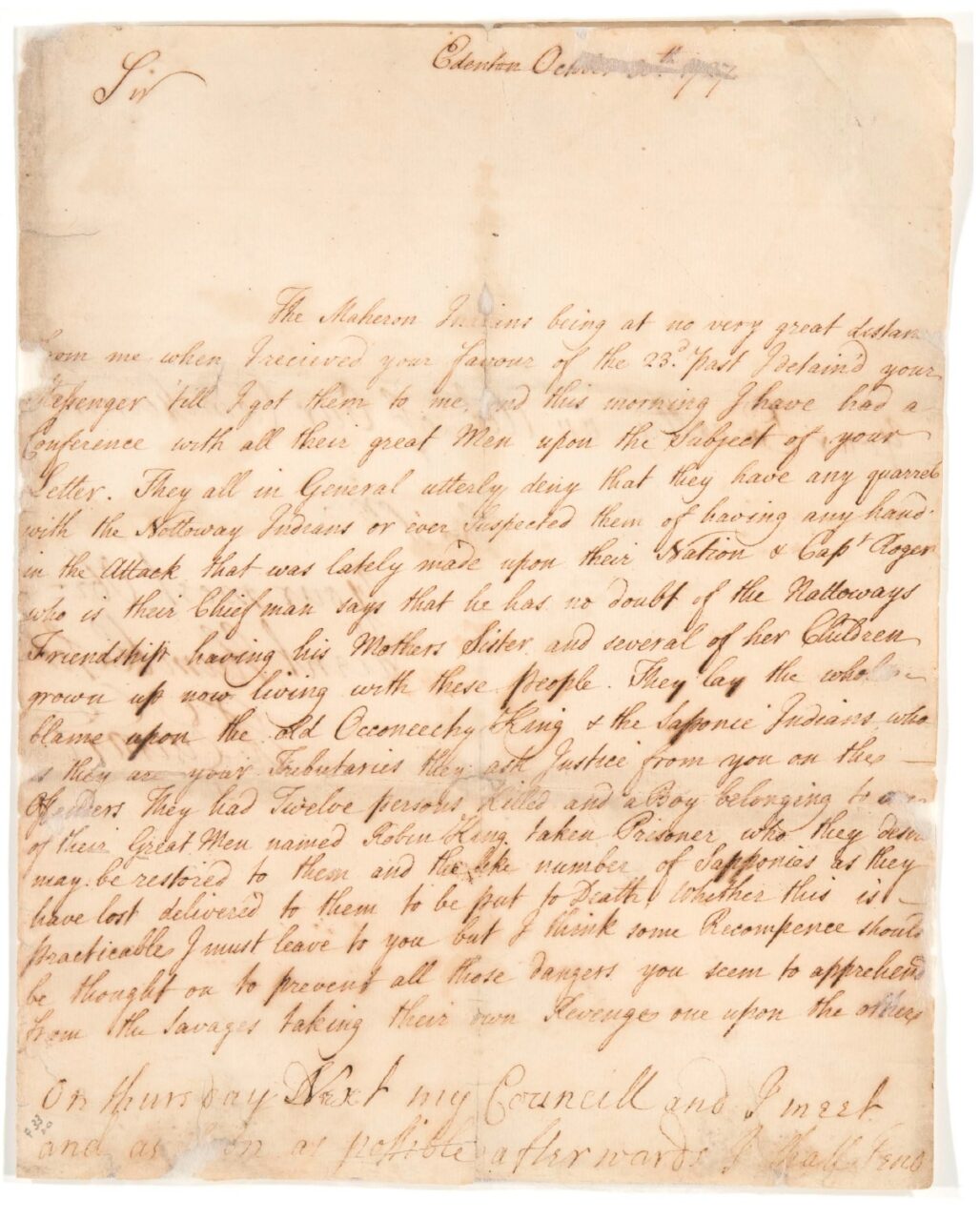
1727
Feb 1, 1727
A letter from [Lieutenant Governor William Gooch] to Richard Everard, [Governor of North Carolina] in response to his letter dated 30 October 1727 regarding the dispute between the Nottoway Indians & Meherrin Indians. According to the letter, a few members of the Saponi Indians went with the Catawbas to guide them to the Tuscarora Indians. Lieutenant Governor Gooch writes that the Saponi Indians should not be held accountable for the action of a few renegades. Gooch also writes that the Saponis have just cause to declare war on the Tuscaroras for murders committed by them last winter.
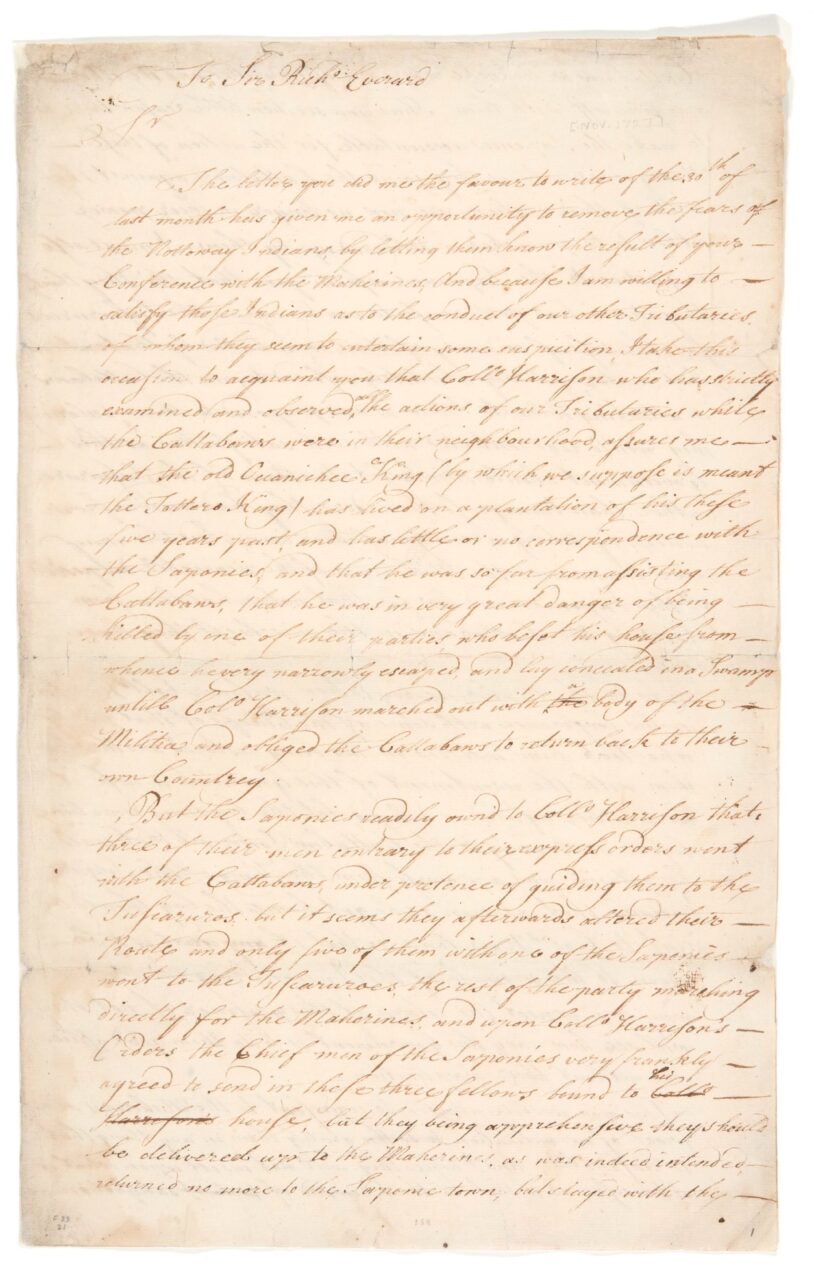
The letter you did me the favour to write of the 30th of last month has given me an opportunity to remove the fears of the Nottoway Indians, by letting them know the result of your Conference with the Maherines, And because I am willing to satisfy those Indians as to the conduct of our other Tributaries, of whom they seem to entertain some suspicition, I take this occasion to acquaint you that Col Harrison who has strictly examined and observed on the actions of our Tributaries while the Cattabaws were in their neighbourhood, assures me — that the old Cuanichee King (by which we suppose is meant the Tattero King) has lived on a plantation of his these five years past, and has little or no correspondence with the Saponies, and that he was so far from assisting the Cattabaws , that he was in very great danger of being — killed by one of their parties who beset his house from –whence he very narrowly escaped, and lay concealed in a Swamp untill Colo Harrison marched out with a body of the — Militia and obliged the Cattabaws to return back to their own Country.
But the Saponies readily own’d to Collo Harrison that three of their men contrary to their express orders went with the Cattabaws under pretence of guiding them to the Tuscaruros but it seems they afterwards altered their Route and only five of them with one of the Saponies, went to the Tuscaruroes, the rest of the party marching directly for the Maherines, and upon Collo Harrison’s orders the Chief men of the Saponies, very frankly agreed to send in these three fellows bound to his Collo Harrison’s house, but they being apprehensive they should be delivered up to the Maherines, as was indeed intended returned no more to the Saponies, town, but stayed with the
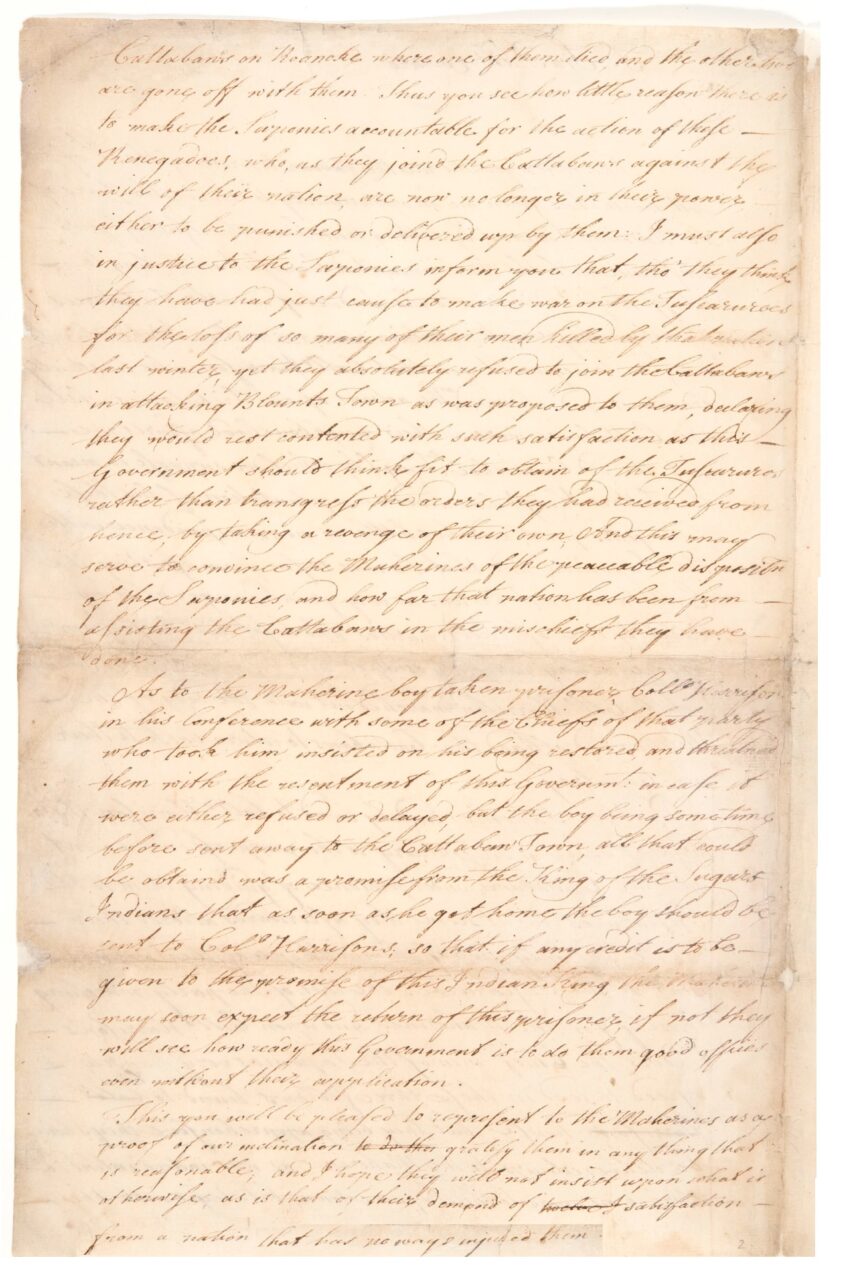
Cattabaws on Roanoke where one of them died, and the other two are gone off with them. Thus you see how little reason there is to make the Saponies, accountable for the action of these Renegades, who, as they join’d the Cattabaws “>Cattabawas against the will of their nation, are now no longer in their power either to be punished or delivered up by them: I must also in justice to the Saponies, inform you that, tho’ they think they have had just cause to make war on the Tuscaruroes for the loss of so many of their men killed by that nation last winter, yet they absolutedly refused to join the Cattabaws in attacking Blounts Town as was proposed to them, declaring they would not rest contented with such satisfaction as this — Government should think fit to obtain of the Tuscarures rather than transgress the orders they had received from hence, by taking a revenge of their own, and this may serve to convince the Maherines of the peaceable dispositn of the Saponies, , and how far that nation has been from assisting the Cattabaws [sic] in the mischief they have done.
As to the Maherines, boy taken prisoner Collo Harrison in his Conference with some of the Chiefs of that party who took him insisted on his being restored, and threatened them with the resentment of this Governmt: in case it were either refused or delayed, but the boy being some time before sent away to the Cattabaw Town, all that could be obtain’dwas a promise from the King of the Sagars Indians that as soon as he got home the boy should be sent to Colo Harrisons; so that if any credit is to be given to the promise of this Indian King, the Maherines may soon expect the return of this prisoner, if not they will see how ready this Government is to do them good offices even without their application.
This you will be pleased to represent to the Maherines, as a proof of our inclination to do ther gratify them in any thing that is reasonable, and I hope they will not insist upon what is otherwise, as is that of their demand of treaties satisfaction from a nation that has no ways injured them.
1727
I had a conference with all their great men upon the subject of your letter. They all in general utterly deny that they have any quarrel with the Nottoway Indians, or ever suspected them of having any hand in the attack that was lately made upon their nation, and Captin Rogers, who is their chief man, says that he has no doubt of the Nottoway friendship – having his mother’s sister and several of her children grown up, now living with these people. They lad the whole blame on the Old Occoneechy King and the Saponi Indians, who as they are your tributaries, they ask justice from you on the offenders. They had twelve persons killed and a boy belonging to one of their great men named Robin King taken prisioner, who they desire may be restored to them, and the like number of Sapponies as they have lost delivered to them to be put to death.”
Calendar of Virginia State Papers (Palmer et al.) (1875) 1727: 214.
1727
November 2nd, 1727.
Mentions the attack on the Meherrin and kidnapping of a Meherrin Boy (son of Chief Robin King).
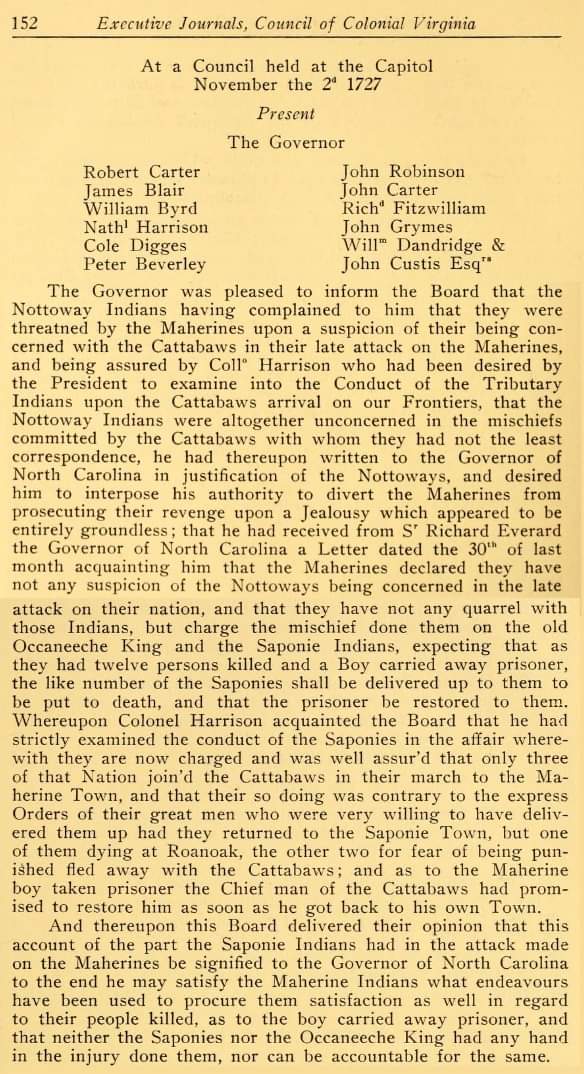
1727
In 1727, William Byrd of Virginia ventured into North Carolina with a surveying party. During his visit to a Meherrin Indian camp he noted in his diary: “The instrument they danced to was an Indian drum, that is, a large gourd with a skin braced taught over the mouth of it.”
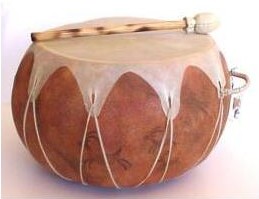
1728
A small group of Meherrin were documented as living among the Nottoway, seeking refuge from the Catawbas who had attacked.
(William Byrd II. The History of the Dividing Line Between Virginia and North Carolina).
1728
Byrd commented in 1728 about the toll of smallpox on Indians in the neighborhood.
(The Secret History of the Meherrin page 96)
1728
By his membership on the Virginia Governor’s Council and his adventures with the final surveying expedition on the border in 1728, Byrd had first-hand experience with the Nottoway, Weyanoke, Nansemond, and Meherrin communities. During the expedition, the survey party had set up camp near the mouth of the Nottoway River,
In this camp three of the Meherrin Indians made us a visit. They told us that the small remains of their nation had deserted their ancient town, situated near the mouth of the Meherrin River, for fear of the Catawbas, who had killed fourteen of their people the year before; and the few that survived that calamity had taken refuge amongst the English on the east side of Chowan. Though if the complaint of these Indians were true, they are hardly used by our Carolina friends. But they are the less to be pitied because they have ever been reputed the most false and treacherous to the English of all the Indians in the neighborhood
(Byrd 1966:213).
(The Secret History of the Meherrin page 102)
1728
A Map of the boundary between Virginia and Carolina laid out by His Majesty’s order and assent of the Lords Proprietors of Carolina in the year 1728 (by William Mayo, 1728)
darmap0316c_200dpi.jpg (12063×3535) (unc.edu)
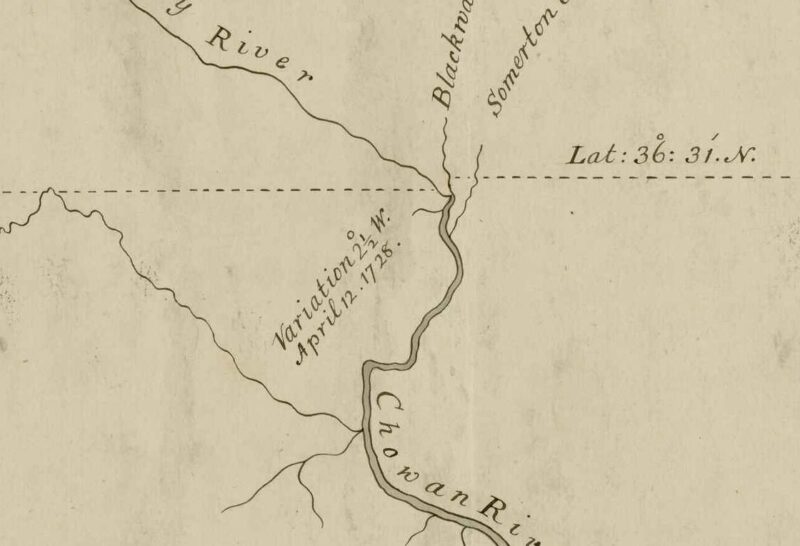

1729
1729 Map of the Dividing Line by Edward Moseley
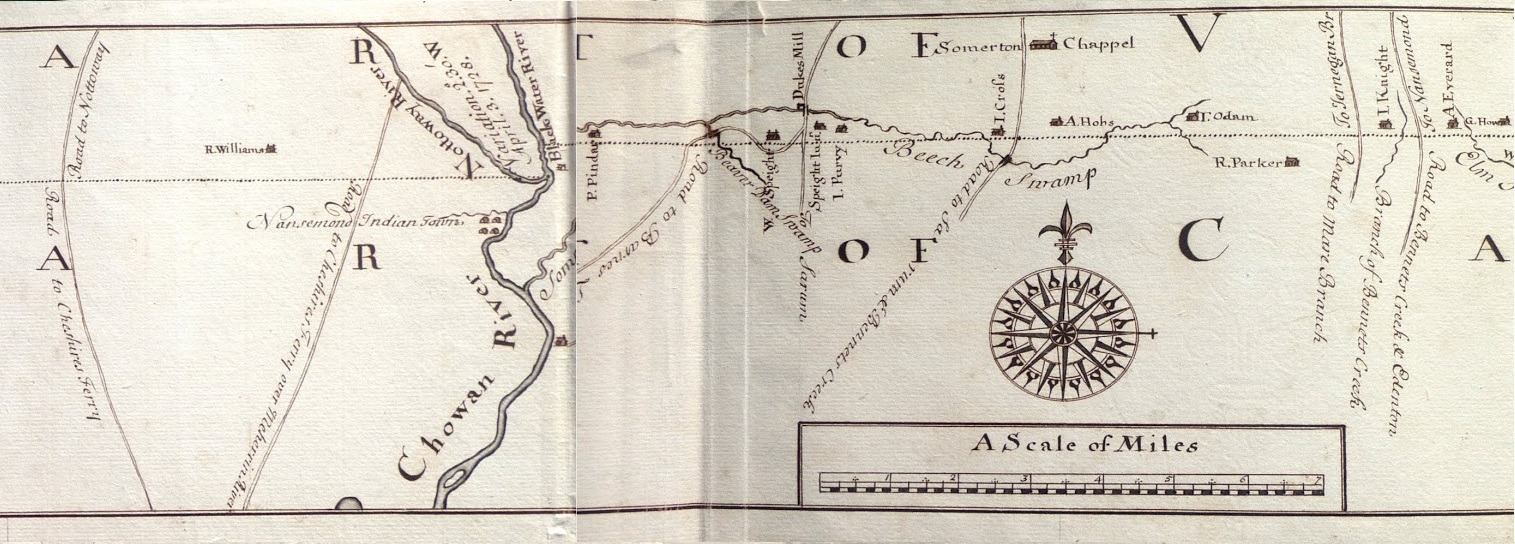
1729
In “An Act for the More Quiet Settling the Bounds of the Meherrin Indian Lands” a new reservation was established at the confluence of the Chowan and Meherrin rivers. This was an expansion of the reservation at Parker’s Fairy.
“all English people, or any other, living in the said bounds, shall move off, and that no persons but the said Indians shall inhabit or cultivate any lands within the limits aforesaid, while the said Indians remain a nation, and live thereon.”
North Carolina. General Assembly November 27, 1729 Volume 25, Pages 211-213
1729
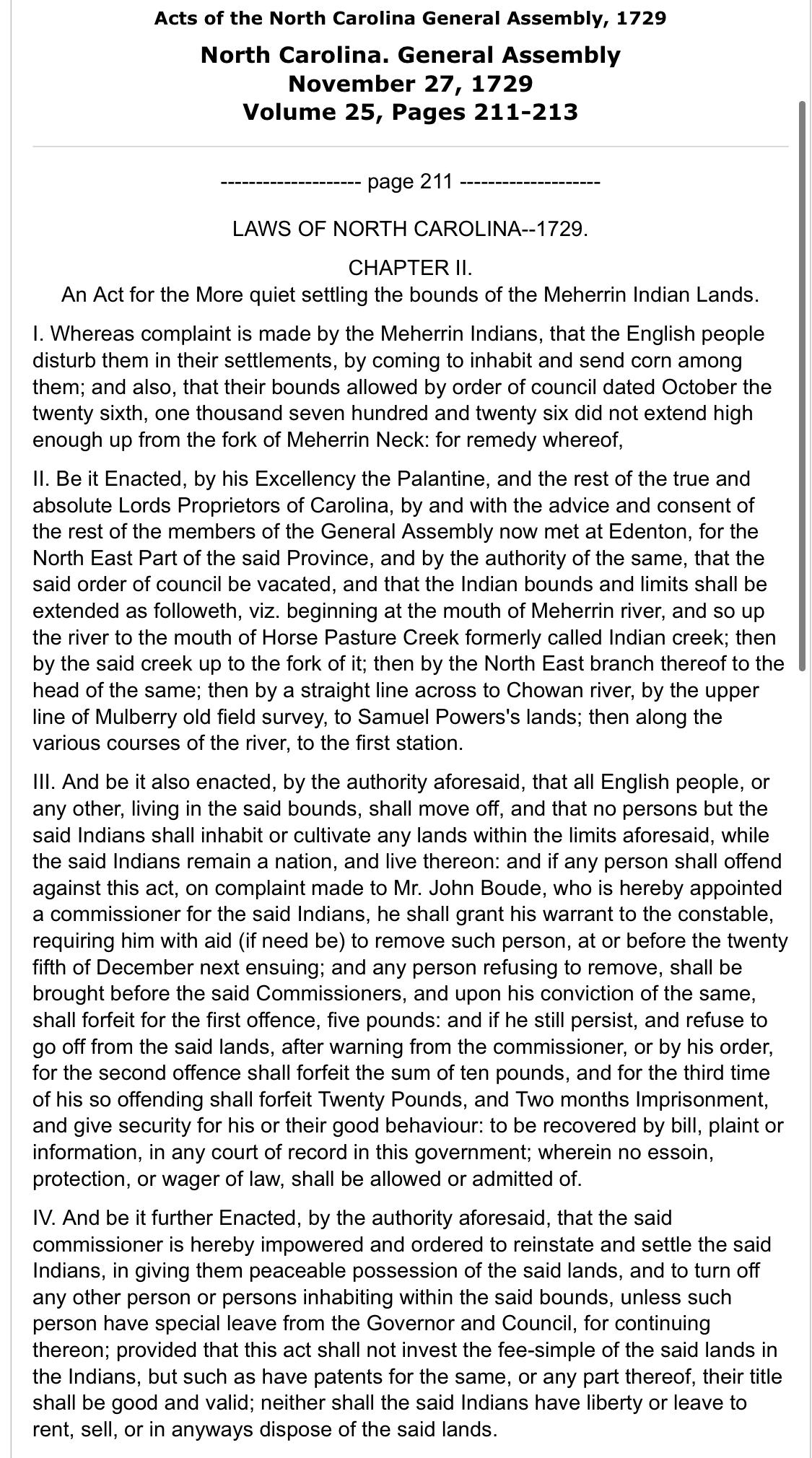
An Act for the More quiet settling of the bounds of the Meherrin Indian Lands.
I. Whereas complaint is made by the Meherrin Indians, that the English people disturb them in their settlements, by coming to inhabit and send com among them; and also, that their bounds allowed by order of council dated October the twenty sixth, one thousand seven hundred and twenty six did not extend high enough up from the fork of Meherrin Neck: for remedy whereof.
II. Be it Enacted, by his Excellency the Palantine, and the rest of the true and absolute Lords Proprietors of Carolina, by and with the advice and consent of the rest of the members of the General Assembly now met at Edenton, for the North East Part of the said Province, and by the authority of the same, that the said order of council be vacated, and that the Indian bounds and limits shall be extended as followeth, viz. beginning at the mouth of Meherrin river, and
so up the river to the mouth of Horse Pasture Creek formerly called Indian creek; then by the said creek up to the fork of it; then by the North East branch thereof to the head of the same; then by a straight line across to Chowan river, by the upper line of Mulberry old field survey, to Samuel Power’s lands; then along the various courses of the river, to the first station.
III . And be it also enacted, by the authority aforesaid, that all English people, or any other, living in the said bounds, shall move off, and that no persons but the said Indians shall inhabit or cultivate any lands within the limits aforesaid, while the said Indians remain a nation, and live thereon: and if any person shall offend against this act, on complaint made to Mr. John Boude, who is hereby appointed a commissioner for the said Indians, he shall grant his warrant to the constable, requiring him with aid (if need be) to remove such person, at or before the twenty fifth of December next ensuing; and any person refusing to remove, shall be brought before the said Commissioners, and upon his conviction of the same, shall forfeit for the first offence, five pounds: and if he still persist, and refuse to go off from the said lands, after warning from the commissioner, or by his order, for the second offence shall forfeit the sum of ten pounds, and for the third time of his so offending shall forfeit Twenty Pounds, and Two months Imprisonment, and give security for his or their good behaviour to be recovered by bill, plaint, or information, in any court of record in this government; wherein no essoin, protection, or wager of law, shall be allowed or admitted of.
IV. And be it further Enacted, by the authority aforesaid, that the said commissioner is hereby impowered and ordered to reinstate and settle the said Indians, in giving them peaceable possession of the said lands, and to turn off any other person or persons inhabiting within the said bounds, unless such person have special leave from the Governor and Council, for continuing thereon; provided that this act shall not invest the fee-simple or the said lands in the Indians, but such as have patents for the same, or any part thereof, their title shall be good and valid; neither shall the said Indians have liberty or leave to rent, sell, or in anyways dispose of the said lands.”
North Carolina Colonial Records (Saunders) XXV: 211. November, 1729
1729
LAWS OF NORTH CAROLINA–1729.
CHAPTER II.
An Act for the More quiet settling the bounds of the Meherrin Indian Lands. I. Whereas complaint is made by the Meherrin Indians, that the English people disturb them in their settlements, by coming to inhabit and send corn among them; and also, that their bounds allowed by order of council dated October the twenty sixth, one thousand seven hundred and twenty six did not extend high enough up from the fork of Meherrin Neck: for remedy whereof, II. Be it Enacted, by his Excellency the Palantine, and the rest of the true and absolute Lords Proprietors of Carolina, by and with the advice and consent of the rest of the members of the General Assembly now met at Edenton, for the North East Part of the said Province, and by the authority of the same, that the said order of council be vacated, and that the Indian bounds and limits shall be extended as followeth, viz. beginning at the mouth of Meherrin river, and so up the river to the mouth of Horse Pasture Creek formerly called Indian creek; then by the said creek up to the fork of it; then by the North East branch thereof to the head of the same; then by a straight line across to Chowan river, by the upper line of Mulberry old field survey, to Samuel Powers’s lands; then along the various courses of the river, to the first station. III. And be it also enacted, by the authority aforesaid, that all English people, or any other, living in the said bounds, shall move off, and that no persons but the said Indians shall inhabit or cultivate any lands within the limits aforesaid, while the said Indians remain a nation, and live thereon: and if any person shall offend against this act, on complaint made to Mr. John Boude, who is hereby appointed a commissioner for the said Indians, he shall grant his warrant to the constable, requiring him with aid (if need be) to remove such person, at or before the twenty fifth of December next ensuing; and any person refusing to remove, shall be brought before the said Commissioners, and upon his conviction of the same, shall forfeit for the first offence, five pounds: and if he still persist, and refuse to go off from the said lands, after warning from the commissioner, or by his order, for the second offence shall forfeit the sum of ten pounds, and for the third time of his so offending shall forfeit Twenty Pounds, and Two months Imprisonment, and give security for his or their good behaviour: to be recovered by bill, plaint or information, in any court of record in this government; wherein no essoin, protection, or wager of law, shall be allowed or admitted of. IV. And be it further Enacted, by the authority
aforesaid, that the said commissioner is hereby impowered and ordered to reinstate and settle the said Indians, in giving them peaceable possession of the said lands, and to turn off any other person or persons inhabiting within the said bounds, unless such person have special leave from the Governor and Council, for continuing thereon; provided that this act shall not invest the fee-simple of the said lands in the Indians, but such as have patents for the same, or any part thereof, their title shall be good and valid; neither shall the said Indians have liberty or leave to rent, sell, or in anyways dispose of the said lands.
(Colonial Native Dispossession of North Carolina Researched by: Baylus C. Brooks Research Assistant: Julie S. Brooks. Page 23)
1730
Lieut. Governor Gooch’s Answer to Queries “The Indians tributary to this Government are reduced to a small number the remains of the Maherin and Nansemond Indians are by running the Boundary fallen within the limits of North Carolina… and the Nottoways on the South side of the James River whose strength exceeds not fifty fighting men.”
B .P.R .O .B .T . Virginia. Vol. 19. R. 127. September 14, 1730.
1730
Virginia acknowledged that the Meherrin actually lived in North Carolina.
The Indians tributary to this Government are reduced to a small number the remains of the Maherin and Nansemond Indians are by running the Boundary fallen within the limits of North Carolina…
(B.P.R.O.B.T. Virginia. Vol. 19. R. 127, September 14, 1730).
(The Secret History of the Meherrin page 102)
1730
After 1730, it is unlikely that the Meherrin could have relied on the skin trade any longer. The bottom fell out of Virginia and North Carolina’s market as the deer populations receded and tobacco planting came to dominate white economic ventures
(Bruce 1907; Theobald 1980).
(The Secret History of the Meherrin page 106)
1731
20 Meherrin families are documented east of the Chowan River in NC, near Bennett’s Creek. This could equate to over 100 individuals.
(The Colonial Records of North Carolina, Second Series – Volume VII – Records of the Executive Council – 1674-1734).
1731
(The Colonial Records of North Carolina – Volume III – 175).

1731
“85th Instruction mentions the Indians here; Of late years they are much diminished, there are six Nations amongst us, they all live within the English Settlements having Land assigned them, and chuseing the Places most secure from the attacks of Forreign Indians that delight in slaughtering one another, the names of our Indian People are the Hatteras, the Maremuskeets, the Pottaskites, the Chowans, the Tuscarora, and the Meherrins not one of these Nations exceed 20 Familys excepting the Tuscarora…”
George Burrington to Duke of Newcastle. NC Colonial Records III: 153. July 2, 1731.
1731
Calendar of State Papers Colonial, America and West Indies
July 1, 1731 As for laws for the conversion of Negroes and Indians, does not expect much will be done, when so little regard is had to promote publick worship. lxxvith Instruction. The Indians of late years are much diminished. There are six nations amongst them, who all live within the English settlements having land assigned them and choosing places most secure from attacks of foreign Indians. These are the Hatteras, Maremuskeets, Potaskites, Chowans, Meherrins and Tuscarora. None exceeds 20 families, except the Tuscaroras who now consist of 200 fighting men etc. There was lately complaints from the Government of S. Carolina of injuries done the white people by the latter, but they denying the facts are threatened by that Government with a war from the Cherokees and Cataubas. The King of the Tuscaroras is now with him to make some proposals, that the white people of S. Carolina may not come against him, because he says it may bring on a war with the English in general.
(Colonial Native Dispossession of North Carolina Researched by: Baylus C. Brooks Research Assistant: Julie S. Brooks. Page 23)
1731
In 1731, George Burrington included the Meherrin in his list of North Carolina tribes, remarking that “not one of these Nations exceed 20 Familys excepting the Tuscarora…” (Saunders, Vol. 111:153; July 2, 1731). This would mean the Meherrin had somewhere in the neighborhood of 80 to 120 people, a 100% decline from their 1702 level.
(The Secret History of the Meherrin pages 105-106)
1733
Meherrin Indian Town located on this 1733 map in present day Maneys Neck, North Carolina.
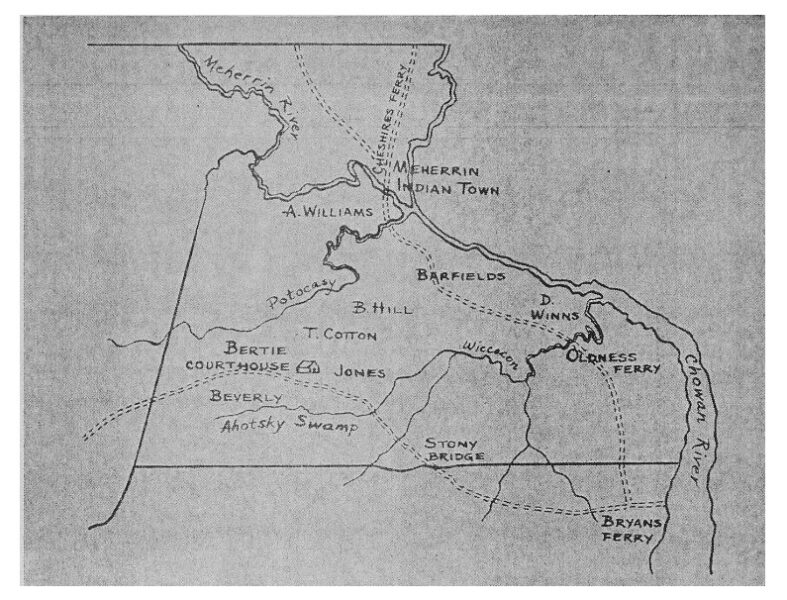
1733
Yeopim territory, Chowan territory, and Meherrin territory are all distinct on the Moseley map of 1733. None of these territories, or reserved lands, was located on the Albemarle Sound as they were in the sixteenth and seventeenth centuries: all are removed significantly to the north of their orginial locations and none, save the Potoskite, are on Albemarle Sound shorelines.
(WEAPEMEOC SHORES: THE LOSS OF TRADITIONAL MARITIME CULTURE AMONG THE WEAPEMEOC INDIANS by Whitney R. Petrey. page 129)
1737
A New and Correct Map of the Province of North Carolina drawn from the Original of Colo. Mosely’s. Published 1737.

1739
1738–1739
A smallpox epidemic decimates the Indian population in North Carolina, especially in the eastern part of the colony.
1742
Read the petition of Thomas Jonekin, and Sundry other Inhabitants of Meherrin Neck – setting forth that they had been in possession of several small Tracts of Land on the said neck for several years; That they had cultivated the same at great expence, and paid quit rents; That the Indians had lately surveyed the said Lands in order to get a patent for the same, and had Included their Lands in the lines, and threatened to drive them off said Land; and therein prayed relief
Delayed till tomorrow afternoon
Read the petition of Jonas Shevers [Chavis?] to the same effect as the foregoing
Referred the Consideration thereof till tomorrow”
North Carolina Colonial Records (Saunders) IV: 615-616. M ay 4, 1742.

1742
Council held at Newberne.
Resumed the Consideration of Thomas Jemagoon’s Petition Yesterday. It appearing that the Indians therein complained of were intitled by Virtue of an Act of Assembly past in November 1729 to all the Land lying between the mouth of the Meherrin River and so up the River to the mouth of horse pasture Creek formerly called Indian Creek then by the said Creek up to the fork of it then by the North Easterly branch thereof to the head thereof then by a straight line across to Chowan River by the upper line of Mulberry old field a Survey of Samuel Powers Land then along the various courses of the River to the first Station so long as they should continue a nation and Inhabit the same
Ordered that the said Indians may quietly enjoy the Land with the bounds mentioned by the said Act of Assembly not seated by the petitioners or other white persons, but that the said petitioners and others in possession of Lands within the said bounds may hold the said Lands upon payment to the said Indians a sum not exceeding five pounds p r hundred acres Virginia money, if they shall demand the same, And that such persons who have not taken out Warrants for the Lands by them respectively held shall be Intitled to the same upon payment of the said sum or other agreements with the said Indians properly certified. And to the end that Strangers may not be imposed upon by the said Indians by their offering to sale any Lands within the said bounds already patented. Ordered that the said Indians do not presume to sell or dispose of any Lands as aforesaid heretofore pretended by the Petitioners or others his Majestys Subjects within this Province…
North Carolina Colonial Records (Saunders) IV: 616-617. May 5, 1742.
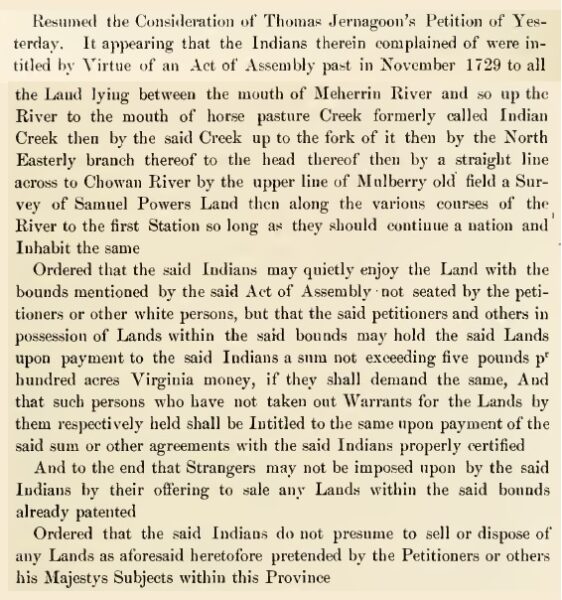
1742
We know that the Meherrin “quietly enjoyed” their reservation until 1742, when Thomas Jemagoon (Jonekin) and “sundry inhabitants” complained to the North Carolina council of Meherrin encroachments. The area under contention was the same northern section of Meherrin territory – around the branching of Indian/Horse Pasture Creek (also called Indian Swamp) – that had been contested with Maule and Gray in the 1720’s and had instigated the creation of the first North Carolina reservation. The Act of 1729 extended the reservation to include land in the neck south of Indian Creek. In 1739 and 1740, a slue of Bertie County deeds for tracts south of the creek passed between white men presuming title from earlier patents which should have been nullified by the 1729 Act.6 Figure 9 approximates the Meherrin’s three known “reservations” located on Meherrin Neck: the land granted by Virginia in 1705, the 1726 North Carolina bounds, and the 1729 extension.
The Jemagoon family purchased 575 acres from a Richard Holland which is described, “on Chowan River known by name Indian Town on SS Indian Creek” (Bertie County Deed Book C:100, also D:22). Jemagoon had to have been aware of the Meherrin claim on the property. It would appear that the Meherrin had a town site on this tract prior to 1728, but had since moved their main settlement back to the mouth of the Meherrin. Regardless, this land was included in the Act of 1729 and the Meherrin began to re-survey the bounds to assert their rights, raising Jemagoon’s alarm. He sent a petition to North Carolina’s council wherein it was reported that the Meherrin “threatened to drive them off the land” (Saunders, Vol. IV:615-616; May 4, 1742).7 The Meherrin still had some fight left in them.
The Council’s response gives us a clue to the mystery of how the Meherrin eventually
lost their reservation land. The council, while recognizing the Meherrin’s legal entitlement to the land, effectively revoked the Meherrin’s exclusive right to occupy and control the land.
Ordered that the said Indians may quietly enjoy the Land with the bounds mentioned by the said Act of Assembly not seated by the petitioners or other white persons, but that the said petitioners and others in possession of Lands within the said bounds may hold the said Lands upon payment to the said Indians a sum not exceeding five pounds pr hundred acres Virginia money… (Saunders, Vol. IV:616-617. May 5, 1742, Document B-73).
In other words, the Meherrin were forced to accept rent from the English squatters and had their rights limited to that land within the bounds not “not seated by the petitioners or other white persons.” The executive order is of dubious legality considering that the 1729 reservation bounds and conditions were set by an Act of Assembly. Even under colonial procedure it should have required a second Act of Assembly to amend the law which specifically prohibited the Meherrin from renting or leasing lands. The document is doubly of significance for specifying for the first time a white/Indian dichotomy. All previous references had been to “English or other Europeans.” An incipient redefinition of social relations into terms of race makes its appearance.
1746
The Meherrin persevered. Perceiving the split in government branches, they petitioned the Assembly directly in 1746. They complained not only of white intrusions (ignoring the order that they view the whites as tenants), but of their appointed commissioner, who had clearly failed to protect their interests. (Document B-74). The records indicate that a second bill for “quieting the possession of the Meherrin Indians” (ibid.) was passed, but unfortunately, we have no record of its content.
(The Secret History of the Meherrin page 108)
1746
House Minutes.
“The House met according to Adjournment. Read the Petition of the Meherin Indians, setting forth the hardships they labour under by reason of the white people intruding on their Possessions and also that the Commissioners appointed by an Act of the General Assembly to settle the said Indians in the quiet possession of their possessions, and praying relief thereon. On reading of which said Petition Mr. Benjamin Hill moved for leave to bring in a Bill pursuant to a prayer of the sd Petition. Ordered that he have leave & that he prepare & bring in the same.”
North Carolina Colonial Records (Saunders) IV: 820. June 17, 1746.
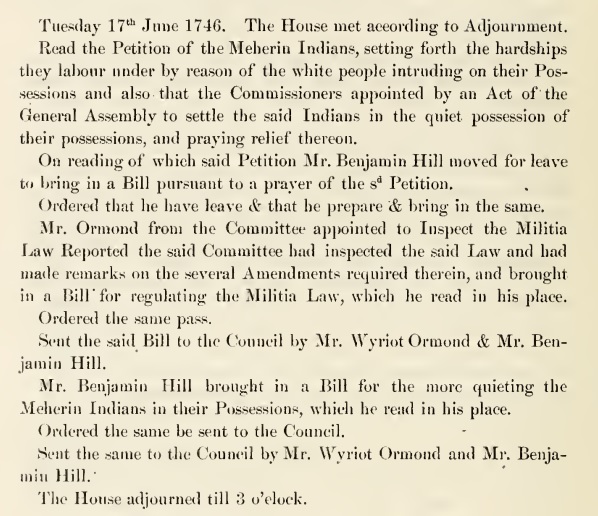
1746
House Minutes.
“Received from the Council the following Bills (that is to say) The Militia Bill and the Bill for quieting the Possession of the Meherin Indians. Endorsed June 18th 1746 In the Upper House read the first time & passed.”
North Carolina Colonial Records (Saunders) IV: 822. June 18, 1746.

1746
House Minutes.
North Carolina Colonia Records IV: 822: 827. June 20, 1747
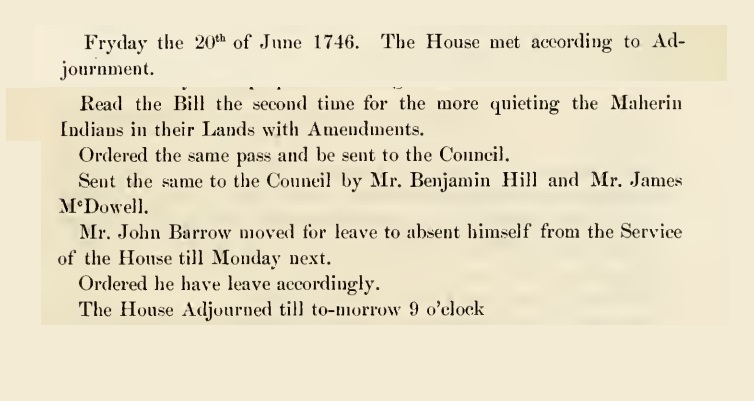
1748
John Dawsons’s Account of Northampton Ridgment
“William Battle, Capt Meherrin Neck 85
Joseph Brett, Lieut’t………..
Elisha Darden, Insoign……….
Two Corpralls & four Searjents.
…The Militia of the s ’d Ridgment are provided Cheifly with Gunns and Swords. Indian Nations, only one, called the Meherrins, and that Consisting of very few in Number.”
North Carolina State Records XXII: 273-274. March 4, 1748
1748
A small number of Meherrin soldiers are counted in a muster of the Meherrin Neck Division of the Northampton Regiment in 1748
(North Carolina State Records XXII:273-274; March 4,
1748).
(The Secret History of the Meherrin page 109)
1752
Map of the Virginia and North Carolina Dividing Line -1752
The map on which this facsimile is based is on a drawing found at the top of a letter of Peter Fontaine Jr. dated 9 July 1752 in Lunenberg,Virginia. Lunenberg, a chaplain and surveyor, accompanied a team surveying the border between Virginia and North Carolina in 1749.
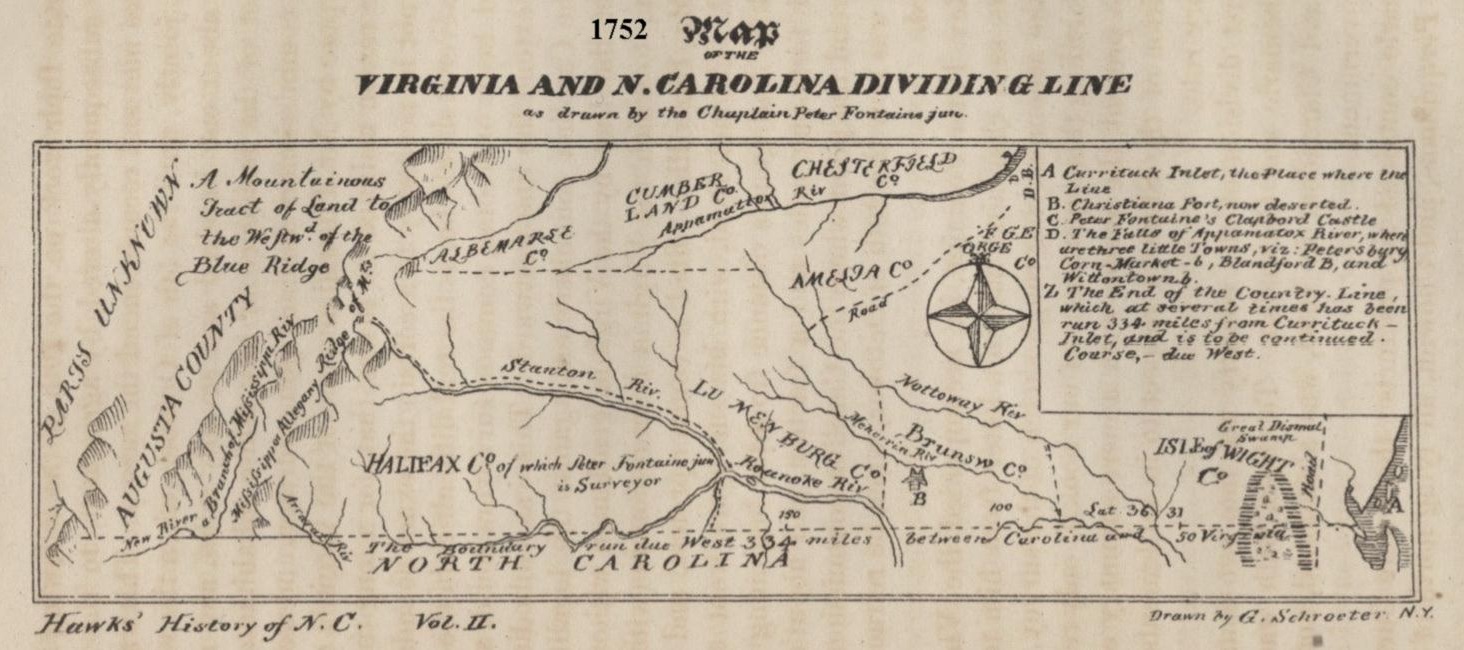
1752
A comment by Bishop Spagenburg hints that the Meherrin may have received another epidemic hit in the late 1740s or early 1750s:
The condition of the Indians in N.C. is rather a deplorable one. The tribe of Chowtuu is reduced to a few families. Their land has been taken away from them. The Tuscaroras live about 35 miles from here & are still in possession of a fine tract of land… Those that have remained here are treated with great contempt, St will probably soon be entirely exterminated. The Meherring Indians live farther to the West* St are also reduced to a mere handful. It would seem that a curse were resting upon them and oppressing them
(Saunders, Vol. V: 1; September 13, 1752).
(The Secret History of the Meherrin pages 109 – 110)
1754
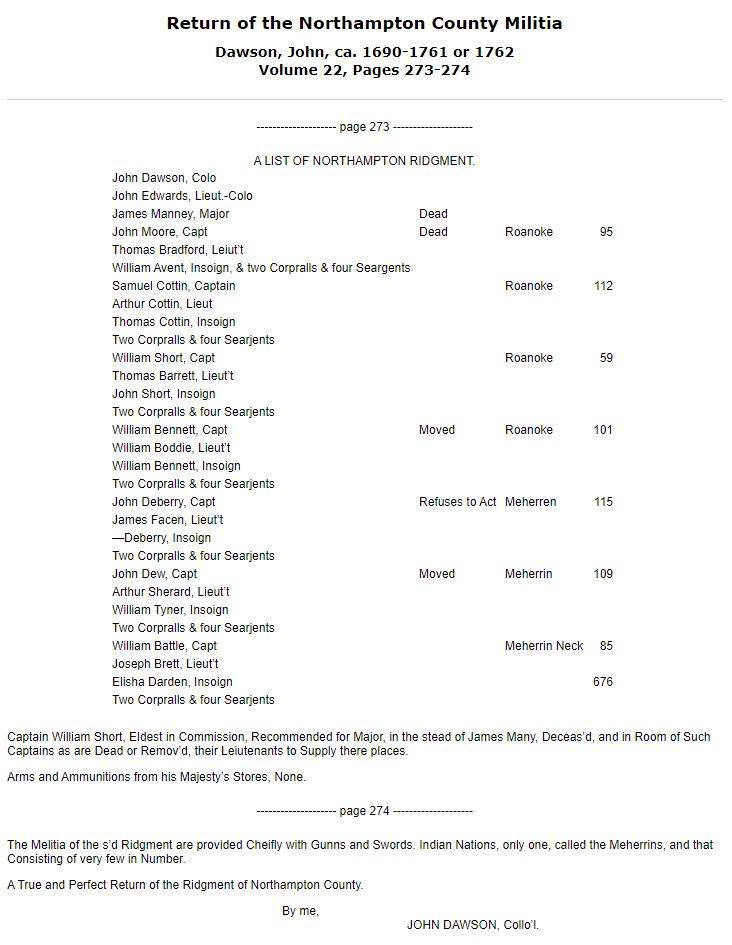
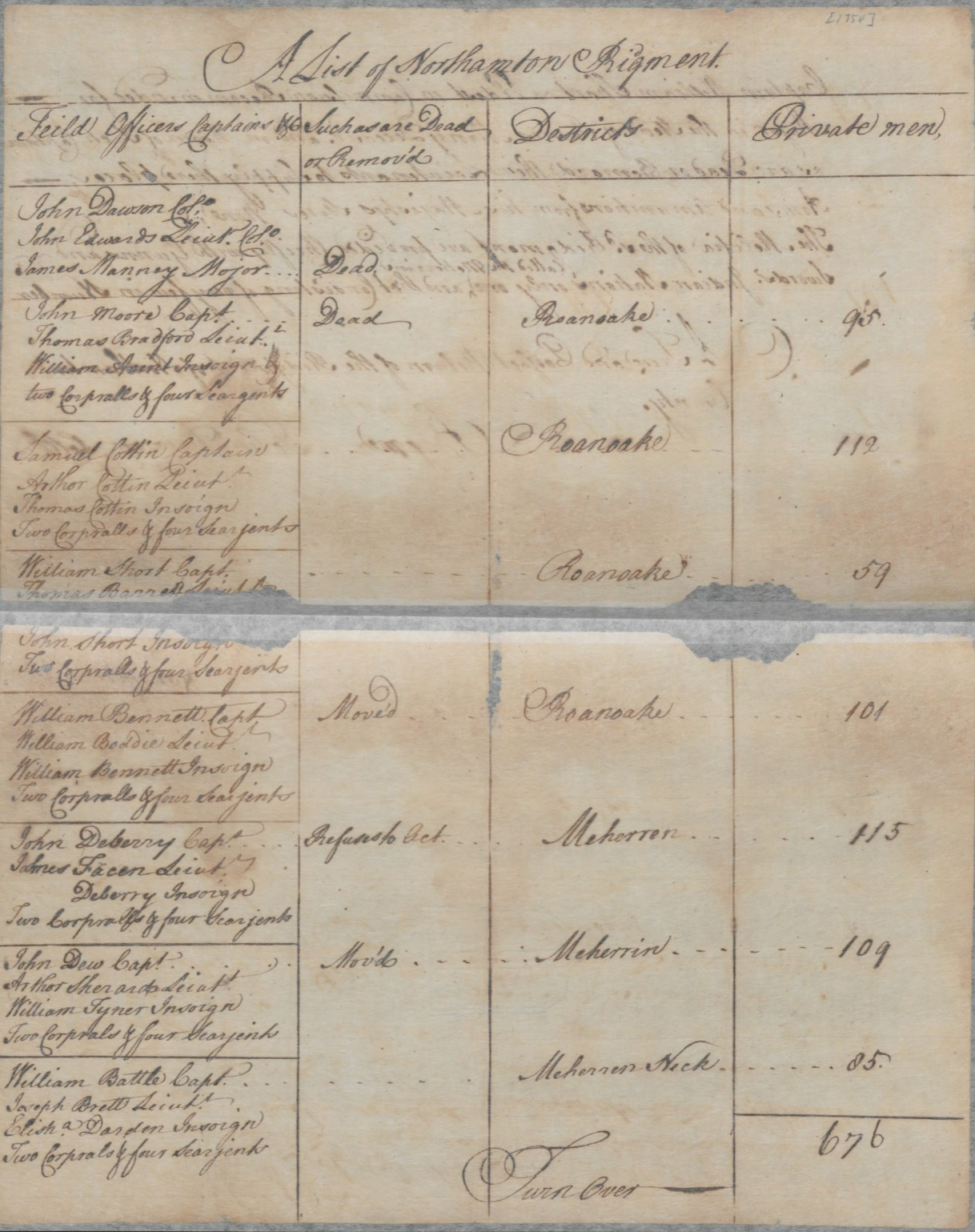

1754
Meherrin – French & Indian War.
Secretary of State Records: Returns from Counties.
“Northampton- Northampton County John Dawson Coll: 7 Companys officers included 739 Captn Willm Short recommended for Major as eldest Captn in Room of Major James Manny deceased The return suggested to be Short by 200 No arms &c in store no Indians but the Meherrins about 708 fighting men. [has to be typo for 7 or 8 fighting men – same report gives Tuscarora of Bertie County 100 men]
North Carolina Colonial Records (Saunders) V: 161-163. December 1754.
1754 -1755
Meherrin – French & Indian War.
In musters of 1754 and 1755, their contribution is specified as “seven or eight fighting
men”
(Saunders, Vol. V: 161-163, 320-321).
(The Secret History of the Meherrin page 109)
1755
A map of the British and French dominions in North America, with the roads, distances, limits, and extent of the settlements, humbly inscribed to the Right Honourable the Earl of Halifax, and the other Right Honourable the Lords Commissioners for Trade & Plantations,
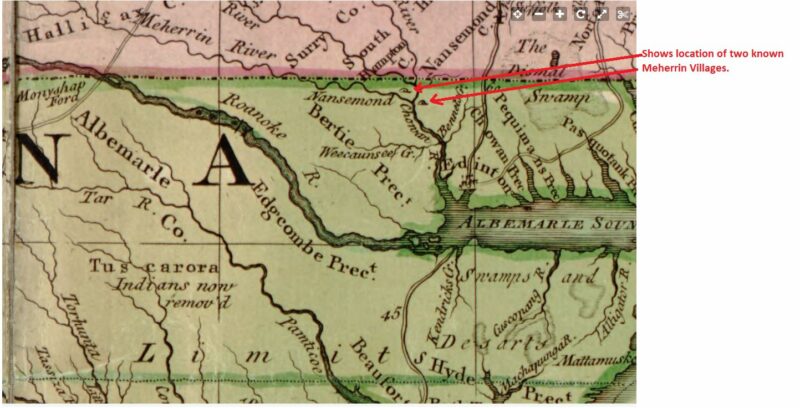
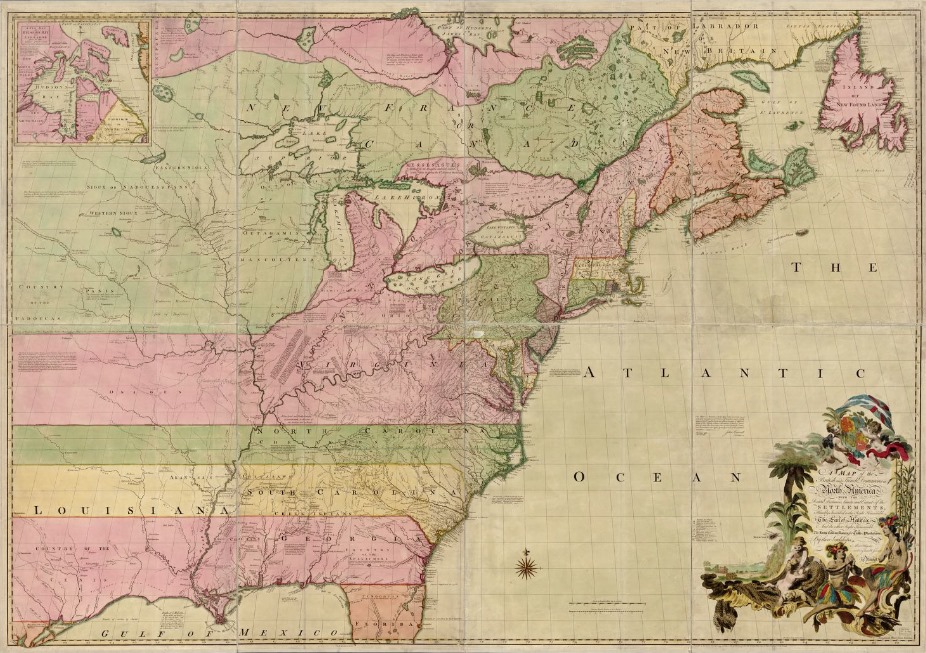
1755
Meherrin – French & Indian War.
Report on Indians in North Carolina.
Northampton County
The Mecharens about 7 or 8 fighting men…
These are all the Indians except about 8 or 10 Maramusket
Indians and as many on the Islands or Banks
North Carolina Colonial Records (Saunders) V: 320-321. January 4, 1755.
